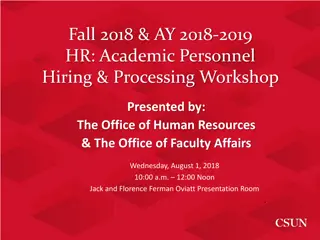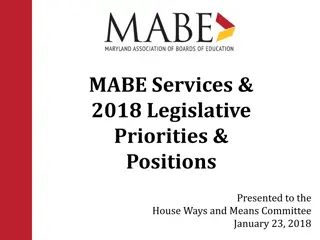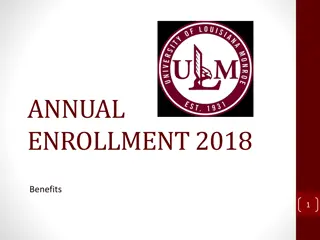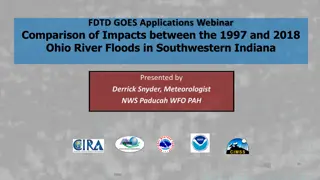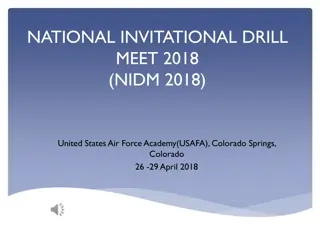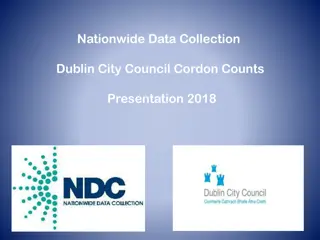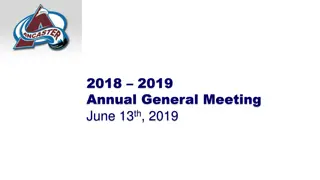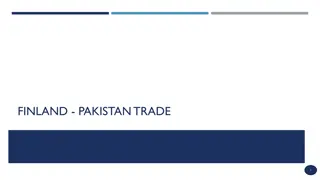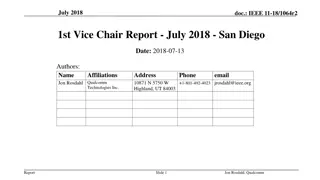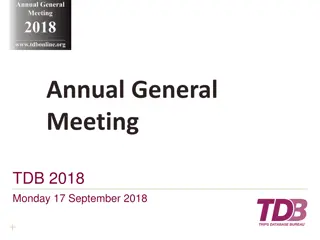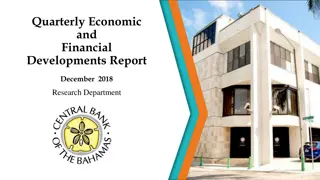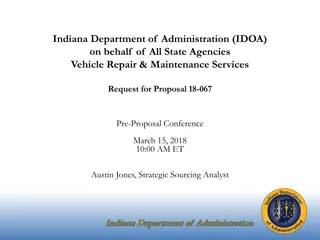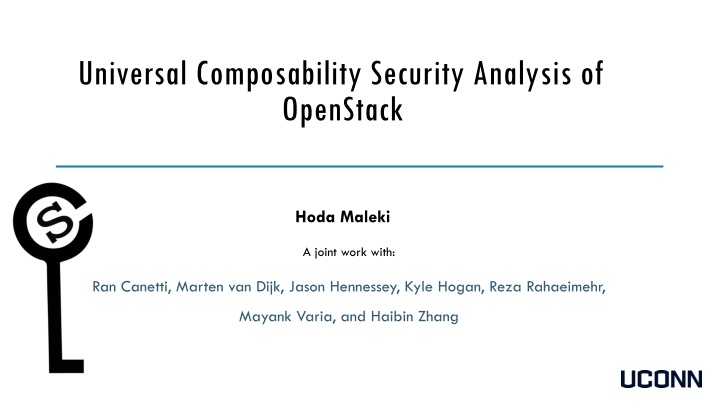
OpenStack Security Analysis and Universal Composability
Explore the security analysis of OpenStack through a universal composability approach. Learn about the platform's reliability, issues, main and optional services, and the general-purpose model for security analysis. Dive into the challenges and complexities of securing a widely used cloud infrastructure platform like OpenStack.
Download Presentation

Please find below an Image/Link to download the presentation.
The content on the website is provided AS IS for your information and personal use only. It may not be sold, licensed, or shared on other websites without obtaining consent from the author. If you encounter any issues during the download, it is possible that the publisher has removed the file from their server.
You are allowed to download the files provided on this website for personal or commercial use, subject to the condition that they are used lawfully. All files are the property of their respective owners.
The content on the website is provided AS IS for your information and personal use only. It may not be sold, licensed, or shared on other websites without obtaining consent from the author.
E N D
Presentation Transcript
Universal Composability Security Analysis of OpenStack Hoda Maleki A joint work with: Ran Canetti, Marten van Dijk, Jason Hennessey, Kyle Hogan, Reza Rahaeimehr, Mayank Varia, and Haibin Zhang
Outlines OpenStack Universal Composability Security Analysis Results Conclusion 2
OpenStack Reliable Open Source Cloud Platform Widely Used 75% of clouds in production or full operational use Infrastructure as a Service (IaaS) Highly Modular 23 main modules Many plug-ins Community based development Model More than 6500 contributors Rapidly growing 6-month cycles 3
IaaS Cloud Platform 4
Cloud Issues Cloud Platform Huge software Many bugs Cloud servers several different applications Isolation Shared underling hardware Bugs Cloud serves many people Attackers, Hackers Privacy, Confidentiality 5
OpenStack Security Issues Cloud issues Difficulty of security analysis More than 10 million lines of code More than 6,500 contributors Lack of clear security model Not well defined APIs Lots of plug ins VMM: KVM, XEN, Hyper-V, VMware 6
Main Services Object storage Image Service Identity Compute Networking Block Storage SWIFT KEYSTONE NOVA NEUTRON CINDER GLANCE 7
User Request flow in OpenStack User Dashboard Identity Token,Request Block Storage Compute result Image Service Networking Object Storage 9
Universal Composability General-purpose model for security analysis of protocols Common understanding and common language The UC approach: Specification via an Ideal-Service The security of a system is reflected only in its effects on the rest of the external environment. Therefore to capture the desired security of system : Write an ideal system that captures the desired effect 10
Universal Composability General-purpose model for security analysis of protocols Common understanding and common language The UC approach: Specification via an Ideal-Service The security of a system is reflected only in its effects on the rest of the external environment. Therefore to capture the desired security of system : Write an ideal system that captures the desired effect 11
Protocol emulation ~ E E API API effects Side- effects Side- A effects Side- S Protocol UC-emulates protocol if for all A there exists S such that for all E, ExecE,A, ~ ExecE,S, . (ExecE, returns the output of E from the execution )
The universal composition theorem E Protocol that emulates protocol Protocol that makes subprotocol calls to E API API ~ Result: A protocol Where: The calls to each MI of are replaced by calls to a MI of Values returned from each MI of are treated as coming from a MI of effects Side- S effects Side- effects Side- E E API API Universal Composability: If we can show that a protocol satisfies some security properties, these security properties will remain even when we compose it with other protocols. ~ effects Side- effects Side- 13
Universal Composability Analysis of OpenStack Steps Define Functionality of Ideal system Define Functionality of the real system Show that real system realize the Ideal system Functionality Propose OpenStack Modifications to realize the Functionalities 14
Services we analyze Image Service Block Storage Compute Identity 15
Ideal Cloud Our ideal cloud functionality provides the user with the following set of commands: Environment Create Node Attach Volume Delete Node Access Node Create Node Attach Volume Delete Node Detach Volume Access Node FOpenStack We study the security properties provided by OpenStack when viewed as a service to external users (which is a typical model for most large scale applications). This includes properties such as: Confidentiality and integrity of data (both in storage and in transition) Confidentiality and correctness of computations APIs 16
Security Analysis Simulator 17
Hybrid World FSMT: Represents the TLS-enabled message bus. It is a secure message transmission functionality that protects the integrity of messages; additionally, it protects the confidentiality of tokens. This is a deviation from OpenStack as-is, which would allow any compromised service to breach message integrity and token confidentiality. FExtNet: External communication between services and users (or their Dashboards) is handled by this functionality, which provides data confidentiality but does not authenticate the message s sender. This modeling decision reflects the fact that OpenStack never verifies whether the user sending the message is actually the owner of the credentials contained therein. 18
Security Analysis Simulator 19
Steps Hybrid World 2 Hybrid World 1 Hybrid World n Ideal World Real World Emulation is transitive: If protocol A UC-emulates protocol B and B UC-emulates protocol C then A UC-emulates C. 20
Example: Delete Node 1- (Receiver, Delete Node , session-id, node-id) Environment 2- ( Delete Node , session-id, node-id, Success/fail) 2 1 Ideal Cloud 21
Example: Delete Node 1- (Receiver, Delete Node , session-id, node-id) 2- (UDashboard, FCompute, Request-Message, token) 3- leak the message after removing token 4- continue message from E 5-Send message (2) to FCompute 6-(FCompute, FIdentity, Service Validation , session-id, Service token, token, Delete node-id ) 7-leak the message after removing token 8- continue message from E 9-Send message (6) to FIdentity 10- (FIdentity, Receiver, Service Validated , session-id, user- id, service-id, Request, valid); Environment 1 18 User Dashboard Protocol 2 17 3,15 External Network 4,16 14 5 Compute Identity 6 10 13 9 7, 11 SMT 8, 12 22
Example: Delete Node 11- leak to E Environment 12- continue message from E 1 18 13-Send message (10) to FCompute 14-(FCompute, Receiver, Delete Node , session-id, node-id, Successful); User Dashboard Protocol 2 17 3,15 External Network 15,16- leakage and continue message 4,16 14 5 17- send result message (14) to UDashboard 18- user receives the result Compute Identity 6 10 13 9 7, 11 SMT 8, 12 23
Example: Delete Node Environment Environment 1 18 1 16 User 2 Dashboard Protocol 3 4 5 2 17 6 3,15 External Network 7 8 9 4,16 Simulator 14 5 Ideal Cloud 10 Compute Identity 11 6 10 13 9 12 7, 11 SMT 13 14 8, 12 15 24
Corrupted Service Different Services get compromise In this situation, we needed to relax ideal cloud in order to provide more information to the simulator. This means less security! Result: When E compromises FIdentity essentially has full control of OpenStack. For other services, if they get compromised, the adversary get access to all the tokens that are being used by that service and may apply different functionalities that the service is able to do or any arbitrary action as well. 25
Security Assertions Authentication & authorization: As long as FIdentity is uncompromised, E is limited to perform only those actions authorized by her projects and roles. Corrupt services can perform actions within their scope on behalf of the environment, but cannot influence uncorrupted services to perform unauthorized actions. User control: By moving away from bearer tokens, we can provide some user control even in the face of service level compromises. Bearer tokens allow a corrupted service to impersonate a user to other, uncorrupted services and perform unintended actions. Resource control: The environment gets restricted from accessing and tampering with user s computing nodes, data volumes, and images as long as two services remain uncompromised: FIdentity and the service managing the object. 26
Conclusion & future work This work lays the foundation for a full-scope composable security analysisfor the popular cloud management framework OpenStack. It brings a number of communities together: Cryptography and programming languages communities Development community Much more work is needed to be done. Mechanizing the analysis, and in particular the proofs of security. 27
Reference On the Universally Composable Security of OpenStack , Cryptology ePrint Archive, Report 2018/602. http:// ePrint.iacr.org/. 2018. Thanks! 28

